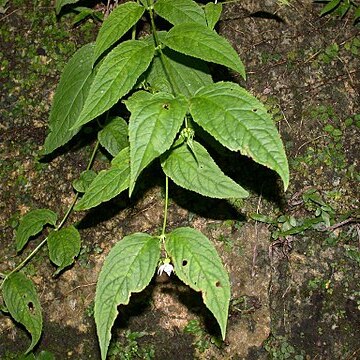Herbs, (perennial or annual), erect or ascending, sometimes lignified at base, usually glabrous throughout. Stems up to 3 m tall, hollow; branches multiple, horizontal or pendulous. Leaves opposite, rarely in whorls of 3, shortly petiolate; blade ovate or ovate-lanceolate to lanceolate, 6-15 × 1-5 cm, margin serrate, dentate, or crenate, apex acuminate. Flowers usually solitary, terminal, or both terminal and axillary, sometimes in a cyme of 3; pedicels or peduncles 1-10 cm, with a pair of filiform bracteoles at middle to top. Calyx adnate to ovary up to lower part of ovary; lobes (4 or)5(-7), filiform or linear, margins with ramiform teeth. Corolla white or pale red, tubular-campanulate, 7-12 mm, 5-or 6-cleft to middle; lobes ovate to ovate-triangular. Stamens 5 or 6; filaments equal to anthers in length, base dilated into lamellar part, margins villous-ciliate. Style glabrous or hairy; stigma (4 or)5-or 6-fid; ovary (4 or)5-or 6-locular. Berry purple-black when mature, globose, (4 or)5-or 6-locular, 5-10 mm in diam. Seeds extremely numerous, subglabrous. Fl. and fr. Jul-Nov.
More
A sprawling herb. It keeps growing from year to year. It can grow 3 m tall. It can be hairy. It is branched and has hollow stems and a tuberous root. The leaves are opposite. The leaf stalks are 3-15 mm long. The leaf blade is oval and 3-14 cm long by 1-4 cm wide. There are teeth along the edge of the leaf. The flowers are 7-15 mm across. They bare white or pale pink and in the axils of leaves. There can be 1-3 flowers together. The fruit is a flattened berry. It is 1 cm across. It is white. There are many small seeds with marks on them.

